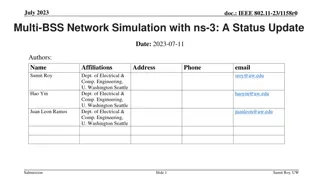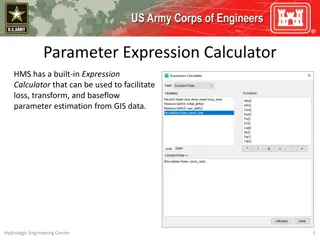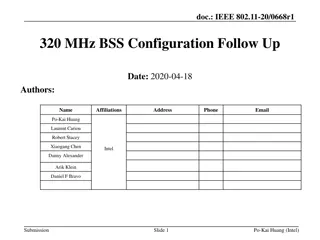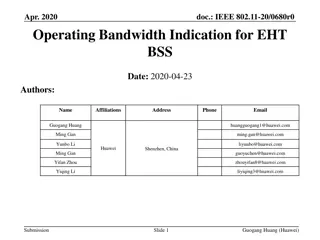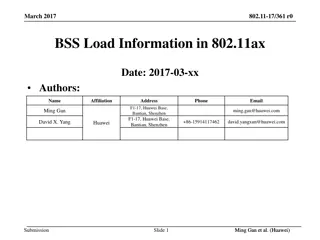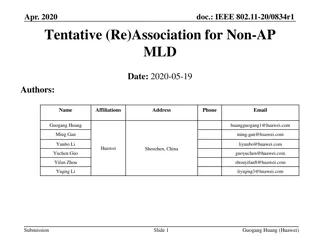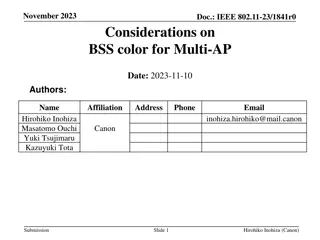IEEE 802.11-21/0036r0 BSS Parameter Update Clarification
This document delves into the IEEE 802.11-21/0036r0 standard, specifically focusing on the BSS parameter update procedure within TGbe D0.2. It details how an AP within an AP MLD transmits Change Sequence fields, Critical Update Flags, and other essential elements in Beacon and Probe Response frames. Additionally, it outlines the operations of non-AP MLD in handling critical updates and decoding flags for clear implementation.
Download Presentation

Please find below an Image/Link to download the presentation.
The content on the website is provided AS IS for your information and personal use only. It may not be sold, licensed, or shared on other websites without obtaining consent from the author. Download presentation by click this link. If you encounter any issues during the download, it is possible that the publisher has removed the file from their server.
E N D
Presentation Transcript
January, 2021 doc.: IEEE 802.11-21/0036r0 Clarification on BSS parameter update Date: 2021-01-05 Authors: Name Affiliations Address Email Jeongki Kim LG Electronics jeongki.kim@lge.com Namyeong Kim LG Electronics namyeong.kim@lge.com LG Seocho R&D Campus, Korea Sunhee Baek LG Electronics sunhee.baek@lge.com Insun Jang LG Electronics insun.jang@lge.com Jinsoo Choi LG Electronics js.choi@lge.com Submission Slide 1 Jeongki Kim, LGE
January, 2021 doc.: IEEE 802.11-21/0036r0 Introduction (1/3) BSS parameter update procedure in TGbe D0.2 An AP within an AP MLD shall include in the Beacon and Probe Response frames it transmits a Change Sequence field for each of all APs in the same AP MLD. The Change Sequence field for each of other APs of the MLD shall be carried in the MLD Parameters subfield in the TBTT Information field of the Reduced Neighbor Report element corresponding to that AP. An AP within an AP MLD shall increase the value of the Change Sequence field for another AP in the same AP MLD when a critical update occurs to any of the elements for that AP. An AP within an AP MLD shall provide in the Critical Update Flag subfield of the Capability Information field of the Beacon and Probe Response frames it transmits an indication of an update to the value carried in the Change Sequence subfield of the MLD Parameters field in the Reduced Neighbor Report element for any AP in the same AP MLD. An AP shall provide this indication in the Beacon frame(s) until (and including) the next DTIM Beacon frame on the link that the AP is operating on. A non-AP STA within a non-AP MLD may decode the Critical Update Flag subfield in the Capability Information field. Submission Slide 2 Jeongki Kim, LGE
January, 2021 doc.: IEEE 802.11-21/0036r0 Introduction (2/3) And, we need to describe the operation of non-AP MLD that can decode the critical update flag in the spec for clear implementation If the critical update flag is set to 0, Non-AP MLD that can decode the critical update flag can skip to parse the change sequence subfield of other APs in the RNR. Otherwise, the MLD will check the change sequence subfield of other APs in the RNR According to the baseline spec, the STA will try to receive the beacon frames every Listen Interval to check if its AP has buffered BUs for the MLD When ReceiveDTIMs is false, STA is not required to awaken for every DTIM Beacon frame When the critical update for other AP(s) happens (i.e., the critical update flag = 1), if the non-AP MLD that can decode the critical update flag is not required to awaken for every DTIM Beacon frame (i.e., ReceiveDTIMs =false), the MLD may miss the Beacon/DTIM Beacon frames containing the critical update flag set to 1 so that the MLD cannot check the critical update of other APs in RNR Submission Slide 3 Jeongki Kim, LGE
January, 2021 doc.: IEEE 802.11-21/0036r0 Introduction (3/3) CUF: Critical Update Flag CSN: Change sequence number LI: Listen Interval BI: Beacon Interval Example Critical update of AP2 CUF=1, RNR (AP2 CSN= 41) CUF=0, RNR (AP2 CSN= 40) CUF=1, RNR (AP2 CSN= 41) CUF=1, RNR (AP2 CSN= 41) CUF=0, RNR (AP2 CSN= 41) CUF=0, RNR (AP2 CSN= 40) AP1 of AP MLD DTIM Beacon Beacon Beacon Beacon Beacon DTIM Beacon Critical update of AP1 CUF=0, RNR (AP1 CSN= 31) CUF=0, RNR (AP1 CSN= 31) CUF=0, RNR (AP1 CSN= 30) CUF=1, RNR (AP1 CSN= 31) CUF=1, RNR (AP1 CSN= 31) CUF=0, RNR (AP1 CSN= 30) AP2 of AP MLD Beacon Beacon Beacon Beacon DTIM Beacon DTIM Beacon STA2 skips to read RNR because of CUF=0 STA2 skips to read RNR because of CUF=0 STA2 of STA MLD LI = 5 BIs Listen Interval When the STA2 wakes up to receive Beacon, the STA cannot check the updated CSNs of other APs Submission Slide 4 Jeongki Kim, LGE
January, 2021 doc.: IEEE 802.11-21/0036r0 Proposal (1/2) Option 1: 2 or 3 bits Critical update flag The value of critical update flag increases by one whenever any update of the change sequence number subfields of other APs happens If the stored critical update flag value is different from the received critical update flag in the Beacon, the STA will parse the RNR and check which AP s critical update happens CUF: Critical Update Flag CSN: Change sequence number LI: Listen Interval BI: Beacon Interval Critical update of AP1 CUF=2, RNR (AP1 CSN= 31) CUF=2, RNR (AP1 CSN= 31) CUF=1, RNR (AP1 CSN= 30) CUF=2, RNR (AP1 CSN= 31) CUF=2, RNR (AP1 CSN= 31) CUF=1, RNR (AP1 CSN= 30) AP2 of AP MLD Beacon Beacon Beacon Beacon DTIM Beacon DTIM Beacon STA2 skips to read RNR because of CUF=1 STA2 tries to read RNR because of CUF=2 Stored CUF=2, AP1 CSN=30 Stored CUF=1, AP1 CSN=30 STA2 of STA MLD LI = 5 BIs Listen Interval Submission Slide 5 Jeongki Kim, LGE
January, 2021 doc.: IEEE 802.11-21/0036r0 Proposal (2/3) Option 2: Receiving all DTIMs always The STAs that can decode the critical update flag should awaken to receive all DTIM Beacon frames (although they doesn t want it) CUF: Critical Update Flag CSN: Change sequence number LI: Listen Interval BI: Beacon Interval Critical update of AP1 CUF=0, RNR (AP1 CSN= 31) CUF=0, RNR (AP1 CSN= 31) CUF=0, RNR (AP1 CSN= 30) CUF=1, RNR (AP1 CSN= 31) CUF=1, RNR (AP1 CSN= 31) CUF=0, RNR (AP1 CSN= 30) AP2 of AP MLD Beacon Beacon Beacon Beacon DTIM Beacon DTIM Beacon STA2 skips to read RNR because of CUF=0 STA2 skips to read RNR because of CUF=0 STA2 reads RNR because of CUF=1 AP1 CSN=31 AP1 CSN=30 AP1 CSN=31 STA2 of STA MLD LI = 5 BIs Listen Interval Submission Slide 6 Jeongki Kim, LGE
January, 2021 doc.: IEEE 802.11-21/0036r0 Proposal (3/3) Option 3: Always checking the RNR A STA that is not required to awaken for every DTIM Beacon frame and is able to decode the critical update flag should always check the RNR element regardless of the value of critical update flag CUF: Critical Update Flag CSN: Change sequence number LI: Listen Interval BI: Beacon Interval Critical update of AP1 CUF=0, RNR (AP1 CSN= 31) CUF=0, RNR (AP1 CSN= 31) CUF=0, RNR (AP1 CSN= 30) CUF=1, RNR (AP1 CSN= 31) CUF=1, RNR (AP1 CSN= 31) CUF=0, RNR (AP1 CSN= 30) AP2 of AP MLD Beacon Beacon Beacon Beacon DTIM Beacon DTIM Beacon STA2 reads RNR although CUF is 0 STA2 reads RNR although CUF is 0 AP1 CSN=31 AP1 CSN=30 STA2 of STA MLD LI = 5 BIs Listen Interval Submission Slide 7 Jeongki Kim, LGE
January, 2021 doc.: IEEE 802.11-21/0036r0 Comparisons Option1 (2 or 3 bits flag) Option 2 Option 3 (Always receive all DTIMs) (Always check RNR) - Need more than 1 bit for signaling the flag field - Need to store updated flag value - No need further bits for signaling STA that doesn t want to see every DTIM need to check all DTIM so that the power consumption will be increased - No need further bits for signaling - STA that doesn t want to see every DTIM need to check RNR always so that the STA requires parsing process of RNR - Submission Slide 8 Jeongki Kim, LGE
January, 2021 doc.: IEEE 802.11-21/0036r0 Conclusion For clarification, we need to describe the expected operation of the non-AP MLD when the MLD can decode the critical update flag If the critical update flag is set to 0, Non-AP MLD that can decode the critical update flag can skip to parse the change sequence subfield of other APs in the RNR. Otherwise, the MLD will check the change sequence subfield of other APs in the RNR Providing some methods to solve problem that the STA MLD does not update the critical update of other AP when the STA MLD is not required to receive every DTIM Beacon frame Option 1: 2 or 3 bits critical update flag Option 2: The STA should always receive all DTIMs Option 3: The STA should always check RNR Submission Slide 9 Jeongki Kim, LGE
January, 2021 doc.: IEEE 802.11-21/0036r0 Straw Poll 1 Do you agree to add the following text in Tgbe SFD as R1 feature? If the critical update flag is set to 0, Non-AP MLD that can decode the critical update flag can skip to parse the change sequence subfield of other APs in the RNR. Otherwise, the non-AP MLD should check the change sequence subfield of other APs in the RNR Submission Slide 10 Jeongki Kim, LGE
January, 2021 doc.: IEEE 802.11-21/0036r0 Straw Poll 2 Which option do you prefer as a method to solve the problem indicated in slide 3 and 4 (Non-AP MLD that is not required to awaken for every DTIM Beacon frame can miss the critical update of other APs) ? Option 1: 2 or 3 bits critical update flag Option 2: The STA should always receive all DTIMs Option 3: The STA should always check RNR Submission Slide 11 Jeongki Kim, LGE































